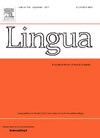Non-standard morphosyntactic variation in L2 English varieties world-wide: a corpus-based study
IF 1.3
3区 文学
0 LANGUAGE & LINGUISTICS
引用次数: 0
Abstract
Previous research has identified and studied a wide range of non-standard syntactic constructions in global varieties of English. However, there is currently a lack of large-scale corpus-based evidence on non-standard syntactic variation in English from a global perspective. The present study seeks to fill this gap through an analysis of a set of syntactic constructions across the fourteen L2 and six L1 varieties of English included in the Corpus of Global Web-based English, totalling 1.9 billion words. We conceptualise non-standard features as lying outside the “core” of the language that represents the object of description in English grammars, including those that might be regarded as “colloquial” or “vernacular”, such as there-existentials with singular agreement. The methodological approach is onomasiological, modelled on the alternation between non-standard features and corresponding standard forms. Across 28 morphosyntactic features drawn from eWAVE 3.0, a total of 289,827 non-standard and more than 37 million standard occurrences were analysed in a logistic mixed effects regression model. Register variation was accounted for by means of a co-variate for involved discourse following Biber’s Multidimensional Analysis. Results indicate a relatively low degree of non-standardness across both L1 and L2 varieties. The register dimension of involved discourse is the most important variable governing non-standard variation, followed by differences between world regions. These results were further confirmed by a hierarchical clustering model and a multidimensional scaling analysis.
世界范围内英语二语变体的非标准形态句法变异:基于语料库的研究
以往的研究发现并研究了全球英语变体中广泛存在的非标准句法结构。然而,目前还缺乏从全球视角对英语非标准句法变异进行大规模语料库研究的证据。本研究试图通过分析全球网络英语语料库中包含的14种第二语言和6种第一语言的句法结构来填补这一空白,这些语料库共包含19亿个单词。我们将非标准特征概念化为位于英语语法中代表描述对象的语言的“核心”之外,包括那些可能被视为“口语化”或“白话”的特征,例如具有单数一致的存在性。方法方法是象形学的,以非标准特征和相应的标准形式之间的交替为模型。在eWAVE 3.0中提取的28个形态句法特征中,采用logistic混合效应回归模型分析了289,827个非标准出现和3700多万个标准出现。根据Biber的多维分析,通过涉及话语的协变量来解释语域变异。结果表明,L1和L2品种的非标准化程度相对较低。涉入语篇的语域维度是影响非标准变异的最重要变量,其次是世界地区差异。层次聚类模型和多维尺度分析进一步证实了这一结果。
本文章由计算机程序翻译,如有差异,请以英文原文为准。
求助全文
约1分钟内获得全文
求助全文
来源期刊

Lingua
Multiple-
CiteScore
2.50
自引率
9.10%
发文量
93
审稿时长
24 weeks
期刊介绍:
Lingua publishes papers of any length, if justified, as well as review articles surveying developments in the various fields of linguistics, and occasional discussions. A considerable number of pages in each issue are devoted to critical book reviews. Lingua also publishes Lingua Franca articles consisting of provocative exchanges expressing strong opinions on central topics in linguistics; The Decade In articles which are educational articles offering the nonspecialist linguist an overview of a given area of study; and Taking up the Gauntlet special issues composed of a set number of papers examining one set of data and exploring whose theory offers the most insight with a minimal set of assumptions and a maximum of arguments.
 求助内容:
求助内容: 应助结果提醒方式:
应助结果提醒方式:


